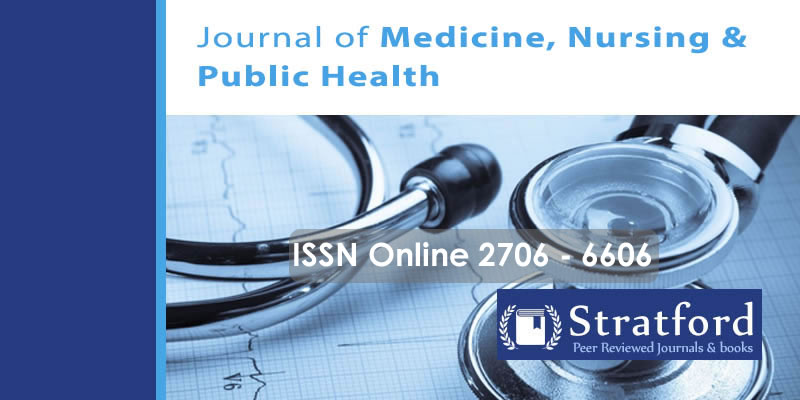Prevalence and Factors Associated with Caeserean Section Among Mothers Delivering at Muhima District Hospital
DOI:
https://doi.org/10.53819/81018102t5159Abstract
This study aimed to understand the prevalence and factors associated with caesarean section among expectant women who had delivered from Muhima hospital. Caesarean section is on the rise globally as well as national average where it accounts 24% of all deliveries conducted in hospitals and this increase has exceeded 15% which is recommended by WHO. A cross-sectional survey was conducted using an interview administered questionnaire and data extracted from obstetric chart review between May and June 2022 at Muhima hospital. A sample of 350 pregnant women that gave birth at Muhima District hospital were chosen using a convenience sampling process, whereby every mother that delivered at latter hospital was given same chances of being enrolled into the study. Data was analysed by use of IBM® SPSS 21 version. Out of 350 pregnant women had delivered at Muhima district hospital, 132 women had been delivered by CS making the prevalence of cesarean section to be 37.7%. Factors associated with CS delivery that were found to be significant were maternal age above 30 years (AOR=2.5,95%CI, 1.1-5.6, P=0.03) being single marital status (AOR=2.5,95%CI, 1.2-5.2, P=0.013) and delivering a baby weighing above 4000 grams (AOR=2.5,95%CI, 0.8-7.2, P=0.103). In conclusion, four out of ten pregnant women had delivered by CS at Muhima district hospital. This was common among older maternal age, being single mother, and delivering of big babies. Thus, it is evident that the prevalence of caesarean section is a growing concern in Muhima District Hospital, with a significant number of women undergoing this procedure. Depending on these factors, the country needs further national level policy decisions to reduce the attributed barriers. There is a need to develop and implement targeted educational programs and counselling services for expectant women, particularly older, single, or expecting big babies. These programs emphasize the importance of prenatal care, the risks and benefits of caesarean sections, and possible alternatives to reduce the likelihood of unnecessary caesarean deliveries. Also, it is recommended to strengthen healthcare provider training and adherence to clinical guidelines for caesarean sections. Moreover, it is essential to establish a comprehensive monitoring and evaluation system to track the rate of caesarean sections in the hospital and identify trends in specific patient populations.
Keywords: Cesarean section, Prevalence, Factors, Pregnant women.
References
Aaisha Amjad, U. A. (2018). Factors associated with caesarean deliveries among child-bearing women in Pakistan:secondary analysis of data from the Demographic and Health Survey,2012-13. BMC Pregnancy and Childbirth , 18, 113. https://doi.org/10.1186/s12884-018-1743-z
Alfred Kwesi Manyeh, A. A. (2018). Socioeconomic and demographic factors associated with caesarean section delivery in southern Ghana:evidence from INDEPTH Network member site. BMC Pregnancy and Childbirth , 18, 405. https://doi.org/10.1186/s12884-018-2039-z
Alice Yuen Loke, L. D.-f. (2015). Factors influencing the decision that women make on their mode of delivery: the Health Belief Model. BMC Health Services Research , 15, 274. https://doi.org/10.1186/s12913-015-0931-z
Altman D, E. A. (2007). Symptoms of anal and urinary incontinence following cesarean section or spontaneous vaginal delivery. Am J Obstet Gynecol , 1-7. https://doi.org/10.1016/j.ajog.2007.03.083
Christian Mazimpaka, E. U.-G.-K. (2020). Perioparative Management and Outcomes After Cesarean Section-A Cross-Sectional Study From Rural Rwanda. HHS Public Access , 390-395. https://doi.org/10.1016/j.jss.2019.07.070
Elizabeth Boskey, P. (2020). The Health Belief Model. VeryWell mind
Emmanuel O Adewuyi, A. A. (2019). Cesarean delivery in Nigeria: prevalence and associated factors-a population-based cross-sectional study. BMJ Open , 9. https://doi.org/10.1136/bmjopen-2018-027273
Fikirte Tsega, B. M. (2015). Prevalence of Cesarean Section in Urban Health Facilities and Associated Factors in Eastern Ethiopia:Hospital Based Cross Sectional Study. Journal of Pregnancy and Child Health .
Goldenberg, M. S. (2016). Cesarean section in sub-Saharan Africa. Maternal Health, Neonatology, and Perinatology .
Health, I. D. (2021). Illinois Maternal Morbidity and Mortality Report,2016-2017. Illinois: Illinois Department of Public Health.
HL, M. (2002). Fears and coping strategies associated with pregnancy and childbirth in Finland. J Midwifery Womens Health. , 47, 256-63. https://doi.org/10.1016/S1526-9523(02)00263-5
Janz NK, B. M. (1984). The health belief model: A decade later. Health Quarterly , 11, 1-47. https://doi.org/10.1177/109019818401100101
MCCH. (2020-2021). Maternal,Child and Community Health Division Annual Report 2020-2021. Ministry of Health, Rwanda Biomedical Centre. Ministry of Health.
Melese Ayalew, B. M. (2020). Magnitude of Cesarean Section Delivery and Its Associated Factors Among Mothers Who Gave Birth at Public Hospitals in Northern Ethiopia:Institution-Based Cross-Sectional Study. Journal of Multidisciplinary Healthcare , 13, 1563-1571. https://doi.org/10.2147/JMDH.S277747
Muhammad Fawad Rasool, S. A. (2021). A Cross-Section Study to Assess the Frequency and Risk Factors Associated with Cesarean Section in Southern Punjab,Pakistan. International Journal of Environmental Research and Public Health , 8812. https://doi.org/10.3390/ijerph18168812
Peter M.Kibe, G. W. (2021). Prevalence and Factors Associated With Cesarean Section in Rwanda: a Trend Analysis of Rwanda Demographic and Health Survey 2000 to 2019-20. Research Square. https://doi.org/10.21203/rs.3.rs-996942/v1
Priyanka Singh, G. H. (2018). High prevalence of cesarean section births in private sector health facilities-analysis of district level household survey-4 (DLHS-4) of India. BMC Public Health , 18, 613. https://doi.org/10.1186/s12889-018-5533-3
RDHS. (2020). Rwanda Demographic and Health Surrvey 2019-20 Key Indicators Report. Kigali: RDHS.
Samuel Hailegebreal, G. G. (2021). Prevalence and associated factors of caesarean section in Ethiopia: a multilevel analysis of the 2019 Ethiopia Mini Demographic Health Survey. BMC Pregnancy and Childbirth , 21, 798. https://doi.org/10.1186/s12884-021-04266-7
Sanni Yaya, O. A. (2018). Disparities in Caesarean section in prevalence and determinants across sub-Saharan Africa countries. Global Health Research and Policy , 3, 19. https://doi.org/10.1186/s41256-018-0074-y
Soha Sobhy, M. A.-M. (2019). Maternal and Perinatal Mortality and Complications associated with caesarean section in low-income and middle-income countries:a systematic review and meta-analysis. THE LANCET , 393 (10184), 1973-1982. https://doi.org/10.1016/S0140-6736(18)32386-9
Vivek Verma, R. K. (2020). Prevalence and determinants of caesarean section in South and South-East Asian women. (A. R. Russell Kabir, Ed.) PLOS ONE , 3. https://doi.org/10.1371/journal.pone.0229906
WHO. (2019). Trends in maternal mortality 2000 to 2017:estimates by WHO,UNICEF,UNFPA,World Bank Group and the United Nations Population Division. Geneva: World Health Organisation.


